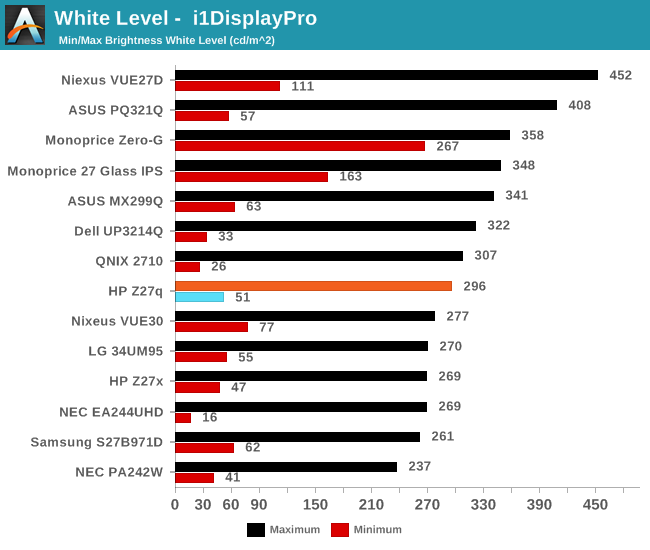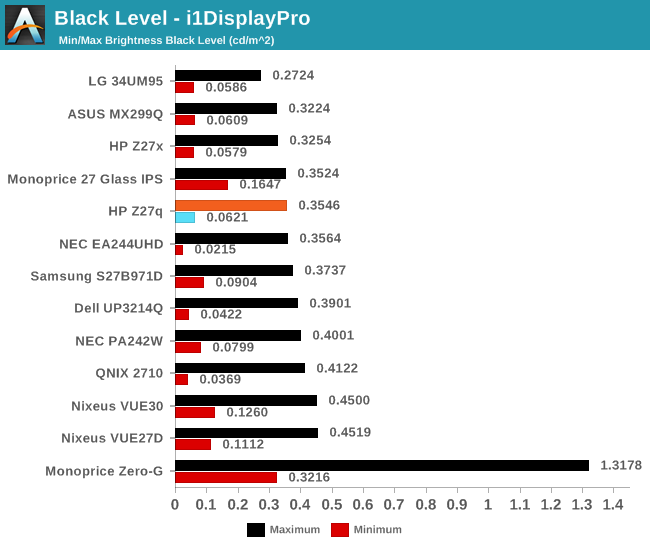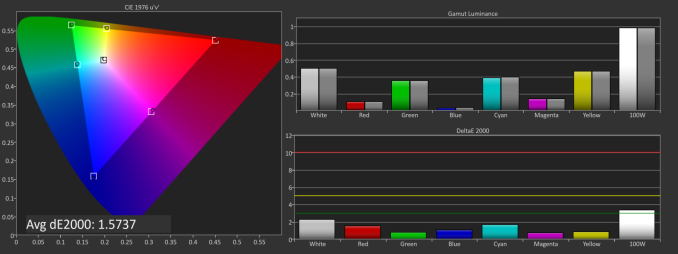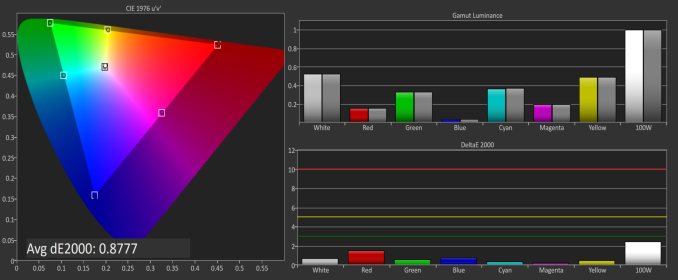HP Z27q Monitor Review: Aiming For More Pixels
by Brett Howse on December 22, 2015 8:00 AM ESTContrast and Brightness
Monitors for desktops don’t need the very high brightness of a tablet or smartphone, since they are used indoors. HP rates the Z27q as a 300 cd/m2 display, and I was able to hit almost exactly that at 296 cd/m2 which is plenty for indoor use. Minimum brightness was 50 cd/m2 so there is quite a bit of dynamic range there to find a suitable brightness for pretty much any office space.

Black levels are pretty consistent with IPS desktop panels, but overall they are a bit too high. Techniques like photo-aligning the backlight and panel can bring some big gains in black levels, but HP is not using such a panel. As such, the overall black levels are less than amazing. Contrast is ultimately not as important as proper gamma for this type of display, but still it would be nice to see better in expensive desktop panels at this point since the technology is available.

This gives us a pretty paltry contrast ratio of 833:1, which is a long way from the 1800:1 seen in some tablets and notebooks. HP is clearly ok with this performance though since it matches the Z27x almost exactly.

Ultimately even though this is a low price for a 5K monitor, it is still far from inexpensive. This is targeted more towards professionals who are after a better overall gamma curve and color accuracy, and consumers may want to stick to a more traditional panel with better contrast for things like watching movies.
Gamut Options
HP offers the very high gamut Z27x display, but the Z27q trades off that gamut for a higher resolution. Still, it can cover both sRGB and AdobeRGB (as well as Rec. 709) and there are built in options for picking the color gamut. The Z27q has a 14-bit LUT, but it is not user accessible, and is calibrated at the factory. Once dialed in, there is no way to adjust it after the fact, so people who are after the utmost in accuracy will likely have to spend a bit more.
Below you can see the gamut options for the Z27q. The additional gamut of AdobeRGB is easily achieved by this panel.
The built in calibration is quite impressive, with the Z27q nicely matching both the sRGB and AdobeRGB spaces with no issues. Some additional options would be nice though, especially DCI/P3, if only because the gamut is likely covered by this display anyway, but there is no way to set the panel to that range.












92 Comments
View All Comments
jbrizz - Tuesday, December 22, 2015 - link
I totally agree. There is no point in pushing technology any further beyond this point. In fact, I might take away all but 640k of your RAM, why would anyone need more than that?Spunjji - Tuesday, December 22, 2015 - link
I don't know if you're using Windows 10 or not, but the DPI scaling is getting very good now.hammer256 - Tuesday, December 22, 2015 - link
Frankly, at ~24" viewing distance, 2560x1440 on 27" works pretty excellently for 1:1. I don't want to sit any closer to my monitors, not comfortable for the eyes. If I was going for 4K, I would want something like a 37". Which is huge. And 3 of them? I'll need a bigger desk. I guess with 4K I can make do with just 2 monitors, but once you go triple monitors, you don't go back ;)geok1ng - Thursday, January 7, 2016 - link
Actually, even 32" is way below the confortable reading limit. Most users complain of the PPI on 24" 256x1440 screens, which have a PPI similar to an hypothetical 34" 4k screen. reading at 1:1 4k is impossible for most users even at the 32" monitors. you can not compare with smartphones screens, because the viewing diustance for smartphones is smaller.MatthiasP - Tuesday, December 22, 2015 - link
It's almost double the price of a 4K display, connects via stopgap MST and doesn't bring much improvement in perceived details at arm's length viewing distance over 4K@27".We 4K display owners are still fine, thank you very much.
quickbunnie - Wednesday, December 30, 2015 - link
Problem is, can you even see 5k resolution at 27 inches and a normal viewing distance? You need to be only 21 inches away for a 4k pixel to take up 1 arc minute, nominally considered the limit of average human vision. At this distance, a 27" display takes up 58.5 degrees of you field of vision, which is very large.Even when editing pixel perfect 1:1 4k video, I'm not sure most people will actually be able to see the extra pixels. If you scoot in and look real close, for sure (which I'm sure many professionals do), but I would say 5k does not automatically mean better for most use cases.
LisaValentin3 - Thursday, December 31, 2015 - link
Prima di poter determinare ciò che schermo è giusto per voi, dobbiamo sapere la vostra situazione. Che cosa hai intenzione di utilizzare il portatile per?<a href=http://schermiportatili.it/hp.html>schermo hp</a>
<a href=http://schermiportatili.it/samsung.html>schermo samsung</a>
gonzo98x - Tuesday, December 22, 2015 - link
What's the deal with the price of this monitor when Samsung can squeeze a 4k display into a 6 inch screen and sell it for far less?Doesn't it take a higher level of specialized technology to cram a 4k resolution into such a small display? To me that would mean a phone display should be more expensive or in the case a 27" monitor should cost less.
So where does the cost come from? Or is this simply another example of setting the price for something 'because they can'. We expect it to be expensive so it is expensive?
I'd love to see a teardown and bill of goods for a monitor such as this.
Insert <thesepricesaretoodamnhigh.jpg>
TheStu - Tuesday, December 22, 2015 - link
I imagine it has something to do with the economies of scale. Whoever is making this panel for HP, they're probably looking at less than 100,000 sales (especially if it is NOT the same panel that's in the 27" iMac). Samsung is going to sell tens of millions of their phone displays.bryanlarsen - Tuesday, December 22, 2015 - link
A 6" display has an area of 15 in^2. A 27" display has an area of over 300 in^2. 20x in size, ~20x in cost, where's the disparity?